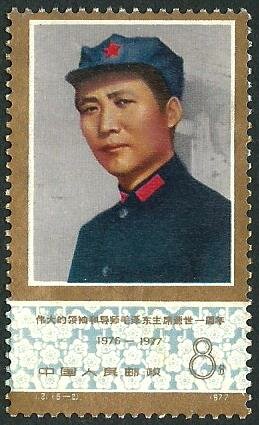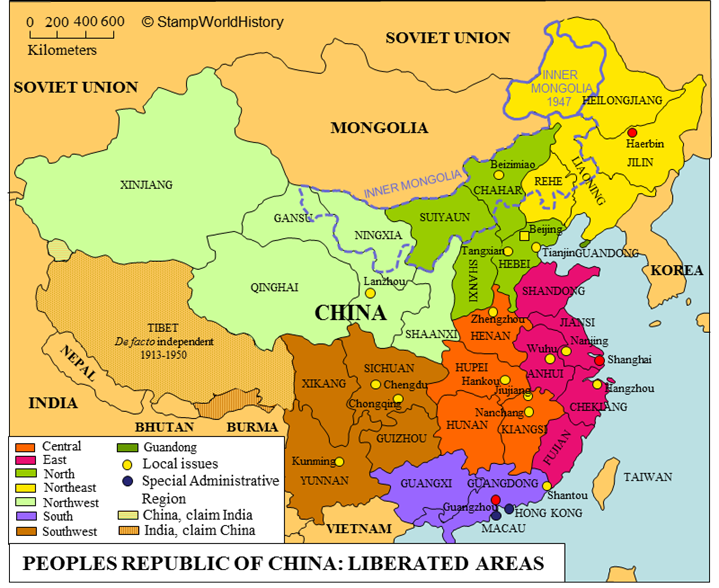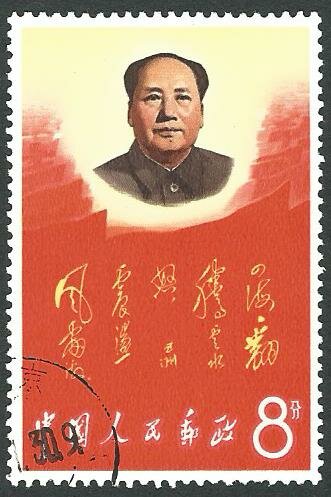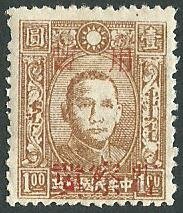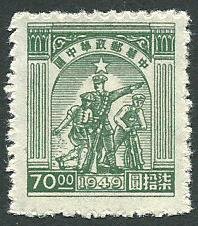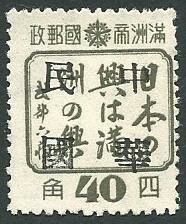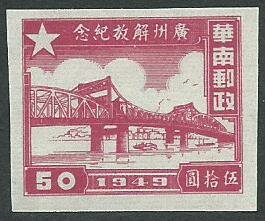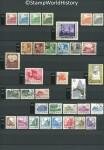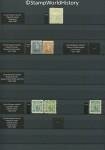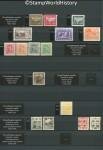中国
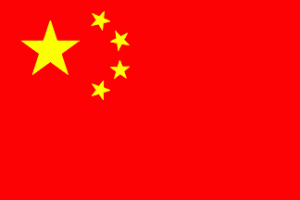
Peoples Republic of China
Quick reference
General issues: Peoples Republic of China 1949-Present
Country name on general issues: China, China in Chinese characters
Special issues:
- Shanxi-Chahar-Hebei Border Area
- General issues 1937-1948
- Local issues: Tangxian 1938, Beizimiao 1945, Rehe 1945, Central Hebei 1946
- Hebei-Chahar-Rehe-Liaoning Region
- General issues 1946-1948
- Local issues: East Hebei 1947
- Guandong
- General issues 1946-1950
- Liberation areas
- Central China
- General issues 1948-1950
- Local issues: Zhengzhou 1948-1949, Hankou 1949, Henan 1949, Jiujiang 1949, Nanchang 1949
- East China
- General issues 1949-1950
- Local issues: Hangzhou 1949, Nanjing 1949, Tungshi 1949, Wuhu 1949, Wushi 1949, parcel post Shandong 1949, (Anhui 1949)
- North China
- General issues 1949-1950
- Local issues: parcel post Beijing 1949, Tianjin 1949
- Northeast China
- General issues 1946-1951
- Local issues 1945-1946
- Northwest China
- General issues 1946-1950
- Local issues: Gansu 1949, Shaanxi 1949, Xinjiang 1949, North Shaanxi 1949, Xinjiang/Eining 1949, Tienshei 1949
- South China
- General issues: 1949-1950
- Local issues: Shantou 1949
- Southwest China
- General issues 1949-1950
- Local issues: Guizhou 1949, Chengdu 1950, Chongqing 1950, Kon-La 1950, Kunming 1950, East Sichuan 1950, West Sichuan 1950, parcel post Guizhou 1950
- Central China
- Special administrative regions
- Hong Kong 1997-Present
- Macau 1999-Present
Currency: 1 Dollar/Yuan = 100 Cent 1949-Present
Population: 541 670 000 in 1949, 1 357 000 000 in 2013
Political history Peoples Republic of China
Establishing the Peoples Republic
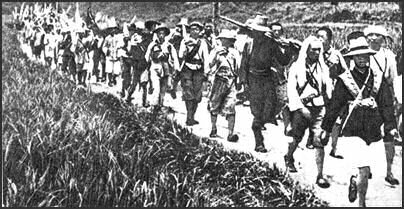
1934 – The Long March
After over 2000 years of imperial rule, the Republic of China is founded in 1912. The Nationalist party is the ruling party at the time. The Communist party is founded in 1921. The following years the Communist party gradually gains support. Tension between the Communist and the Nationalist parties increases and, in 1927, the tension escalates into an armed conflict. The base of power of the Communist party is at first in the south China province of Kiangsi. When confronted with a Nationalist offensive, the Communists start the ‘Long March’ in 1934 and move their power base to the north China province of Shaanxi. The Communist party is led, from 1935, by Mao Zedong. After the Japanese invasion in 1937, the Communist and Nationalist parties join forces to fight the Japanese. After the Japanese capitulation in 1945, the struggle for power resumes. The Communists gradually control larger parts of mainland China. In 1949, the Peoples Republic is proclaimed. The Nationalists withdraw to Taiwan – formerly called Formosa – where they continue as the leading party of the Republic of China as it is established on Taiwan. Since then, both the Peoples Republic and the Republic of China claim sovereignty over all of China.
Shaping the Peoples Republic
As the Communists control larger parts of China, the administrative division in Communist China changes frequently. A level of administration above that of the provinces is introduced, that, in the 1940’s, develops into the establishment of Liberation Areas. The Liberation Areas under effective Communist control are: Central China, East China, North China, Northeast China, Northwest China, South China and Southwest China. The first to be formed was Northeast China in 1946. Northeast China had been occupied since 1931 by the Japanese who had established the state of Manchukuo in the region. After the Japanese capitulation in 1945, the Soviet Union had occupied the region that was returned to China in 1946. An exception being Guandong – the area with the ports of Dairen and Port Arthur, leased first to the Russians, then the Japanese – that in 1946 came under joint Chinese and Soviet administration. In 1952, the Soviets relinquished their rights in Guandong, the Soviet Union thus being the last nation to relinquish the extraterritorial rights that had been granted to foreign powers in the days of the Chinese Empire. Tibet is de jure also one of the Liberation Areas. De facto, however, Tibet has been independent since 1913 and effective Chinese control is not restored until 1950. Aside from the Liberation Areas, in 1947, the autonomous region of Inner Mongolia is established, at first only in part of the Heilungkiang province, in later years to be extended to its current form.
Also, after the establishment of the Peoples Republic, the administrative divisions are again changed several times. One of the changes being the dissolution of the Liberation Areas. Notable is the incorporation of Hong Kong and Macau – until then British and Portuguese colonies – in 1997 and 1999. Hong Kong and Macau form Special Administrative Regions with a certain amount of self government.
Foreign policy: gaining international recognition and conflicts
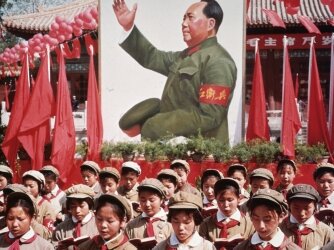
Cultural revolution
The Peoples Republic, for a long time, is strongly influenced by the Soviet Union and, next to the Soviet Union, is one of the large players in the Cold War. In the 1960’s China starts to sail an increasingly independent course, which from the 1970’s on, also leads to relaxation of the relations with Western countries. International recognition at first is limited though. Many countries recognize the Republic of China, as established on Taiwan, as the legitimate government of all of China. The Peoples Republic has to wait until 1971 before growing international recognition is translated in the Peoples Republic of China, replacing the Republic of China as the sole representative of China in the United Nations.
China, during the Cold War, supports communist movements worldwide. Thus, China becomes involved in both the Korean war[1] 1950-1953 and the First and Second Indochinese wars[2]1946-1954 and 1955-1975 . Furthermore, China has been involved in armed conflicts with neighboring India in 1962 and Vietnam in 1979. The conflict with India was triggered by border issues, a conflict that ended in the the status quo ante bellum. The border dispute has yet to be resolved. The conflict with Vietnam was triggered by the Vietnamese intervention in Cambodia the same year – an intervention that China opposed. The Chinese troops withdrew shortly after their invasion of Vietnam, both parties claiming victory.
Domestic policy: Maoism and liberalization
The domestic policy of the newly established Peoples Republic was focused on modernizing the country through a communist approach. In the late 1950’s, early 1960’s, China launches the ‘Great Leap Forward’ aimed at industrialization and agricultural reform. The Great Leap Forward, however, has dramatic effects on China’s economy. Food shortages lead to a famine that kills tens of millions of Chinese. These developments seriously weaken the position of Mao Zedong. To reconfirm his position, Mao, in 1966, initiates the ‘Cultural Revolution’ – a Maoist style program of cultural, political end economic reforms.
After Mao’s death in 1974, the reforms of the Cultural Revolution are largely turned back and slowly the country is put on a more liberal course – a liberalization that will mainly affect the economy. Politically China remains a one party state with the Communist party in full control. Economically though, China has known substantial growth and its economy currently ranks second only to that of the United States.
Postal history Peoples Republic of China
The Communists first started to set up postal services in the areas under their control in the second part of the 1930’s in the north of China, where they had their power base since the Long March in 1934. After WWII, in the second part of the 1940’s, much more widespread postal services were set up until, by 1949, most of mainland China had postal services on the level of the Liberation Areas. The issues of the Liberation Areas were superseded in 1950 by those of the Peoples Republic that started issuing stamps centrally in 1949.[3]As China has, in recent years, been on a path of liberalization and has opened up to the Western world, new issues from the period just prior to the establishment of the Peoples Republic of China – the period of the Liberation Areas – have been appearing. Currently, the worldwide catalogs differ greatly in the way these issues are listed. The catalogs differ in which issues are listed, under which heading issues are listed, on the date of issue and on the translation of overprints. As such, this period in the postal history of China seems to also be a field of study for the editors of the worldwide catalogs. Probably specialized catalogs are ahead of the worldwide catalogs. As the scope of the profiles on this site is that of the worldwide catalogs, I have mainly followed the catalog that currently has the most extensive listing, this being the Michel catalog. I have used additional information from other catalogs where appropriate. For a more detailed analysis of how issues from the different stamp issuing entities are listed in the four catalogs please refer to the cross reference of catalogs in the list of stamp issuing entities elsewhere on this site.
Shanxi-Chahar-Hebei Border Area and Hebei-Chahar-Rehe-Liaoning Region
The first stamp issues listed for the Communist controlled areas are 1937 issues for the Shanxi-Chahar-Hebei Border Area. The issues are definitives and overprints on stamps of the Japanese occupation – mostly reading ‘For temporary use’. Local definitives issued in 1938 are listed for Tiangxian in the Hebei province and local overprints for Beizimiao in the Chahar province. Regional overprints are listed for Rehe in 1945 and the central Hebei district in 1946.[4]The listing – in Michel – for Rehe under the heading of the Shanxi-Chahar-Hebei Border Area is confusing as Rehe would not seem to have been part of this region. The issues of the Shanxi-Chahar-Hebei Border Area are followed, from 1946 to 1948, by issues for the Hebei-Chahar-Rehe-Liaoning Region. For this period, a regional issue is listed for the district of East Hebei in 1947. The stamps of these regions are superseded by those of the North and Northeast Liberation Areas.
Guandong
In the context of the joint Chinese and Soviet administration established in 1946, the Chinese set up a postal service for the area. This postal service goes by several names between 1946 and 1950: Liaoning Postal Administration, Port Artur and Dairen Postal Administration, Guandung Post and Telegraph General Administration and finally Port Arthur and Dairen Post and Telegraph Administration. The stamps issued, as of 1946, are stamps of Japan and Manchukuo overprinted with the name of the postal administration and a new the face value. In 1949 definitives follow. In 1950, the stamps of Guandong are superseded by the general issues of the Peoples Republic.
Liberation Areas
As the many administrative divisions in the Communist controlled areas develop into the Liberation Areas, the postal services are also set up on the level of the Liberation Areas. In some Liberation Areas stamps were issued before the formal establishment of the particular Liberation Area. The stamps of the Liberation Areas were superseded by the general issues of the Peoples Republic in 1950, with the exception of North East China where the general issues of the Peoples Republic were introduced in 1951. A closer look:
-
Central China: The Central China Liberation Area is established in August/September 1949. Stamps, however, have been issued in the area as of November 1948. The first issue being a local issue in Zhenzhou in the province of Henan . These are followed by definitives of a rather crude design. In June 1949, stamps are issued in the name of the Hupei Postal and Telegraph Administration in Hankou and the Kiangsi Postal And Telegraph Administration in Nanchang. Both are overprints – the first reading ‘Chinese P.O. Temporary Use’, the second reading ‘Peoples Post Kiangsi’. Local issues again appear in July 1949, now in Jiujiang in the province of Kiangsi. In July 1949, more sophisticated definitives are issued. In August stamps are issued in Henan in the local currency. These are overprints reading ‘Henan People Currency’ – different currencies were a common phenomenon in China. Parcel post stamps are issued in 1949. The last stamps are issued by Central China in 1950.
- East China: The East China Liberation Area was established in July 1948. It was preceded by the a postal service set up in the province of Shandong in 1941. The first stamps issued in the area are issues in March 1948, these being definitives with the portrait of Mao Zedong. More definitives follow until, in late 1949, the last stamps are issued. Local overprints are issued in May 1949 in Hangzhou, Nanjing, Tungshi, Wuhu and Wushi.[5]The cities of Tungschi and Wushi have not been located, hence are not found on the map in this profile. The overprints reading ‘East China’ and/or a new face value. Disputed is a 1949 issue for the Anhui province. Parcel post stamps have been issued as of July 1949, all overprints on preceding parcel post issues of the Republic of China.
- North China: The North China Liberation Area was formally established in May 1949, having its roots in the postal service set up by the Communists in China in the Shanxi-Chahar-Hebei Border Area in 1937. Stamps are listed as issued in the area from January 1949 until December 1949. The issues of North China are both definitives and overprints, the overprints mostly being a new face value on stamps issued by Northeast China. Parcel post stamps have been issued since May 1949 with local issues for Beijing and Tianjin.
-
Northeast China: The Northeast China Liberation Area was the first Liberation Area to be established in 1946 when the former Japanese puppet state of Manchukuo – occupied in 1945 by the Soviet Union – was returned to China. Parts of Northeast China fell into the hands of the Nationalists, parts into the hands of the Communists. The first stamps to be issued were local overprints issued by local post offices in many varieties. These appeared both in the areas controlled by the Nationalist and the Communists.[6]These stamps are referred to, but not listed, in the catalogs. A detailed study of the stamps is found on this site: Manchurian Local Overprints. The organization of the postal service gradually developed until, in 1948, it covered all of Northeast China. Before the Northeast Postal Service was fully established, the postal authorities went by names such as ‘Ministry of Posts and Telegraphs’ and ‘Communications Committee of the Political Council’. Most stamps of Northeast China are definitives issued between November 1946 and May 1951. Some of these were overprinted with a new face value. As Northeast China had a different currency from the rest of China, the stamps of Northeast China were used longer than those of the other Liberation Areas until 1951.
- Northwest China: The Northwest China Liberation Area grew out the preceding Shaanxi-Gansu-Ningxia Border Area as established in 1936. Shaanxi was the end of the ‘Long March’ through which the Communists had relocated from southern China to northern China in 1934. Stamps have been issued in the area from March 1946 until October 1949. The first issue being definitives with the face value inscribed in both Chinese and Arabic. Arabic is the script used in the Uyghur speaking population of Xinjiang. Regional overprints have been issued, in 1949, in Shaanxi in the city of Lanzhou, in Gansu and in Xinjiang. The overprint reading ‘Peoples Post’ and in the case of Shaanxi ‘Peoples Post Shaanxi’. The post office of Eining issued definitives in February 1949 for use in Xinjiang. A local overprint with a new face value and and an overprint reading ‘Peoples Post’ was issued in August 1949 in Tienshei.[7]The cities of Eining and Tienshei have not been located, hence are not found on the map in this profile. Finally a regional overprint with a new face value was issued in the district of North Shaanxi in September 1949.
-
South China: The South China Postal and Telegraph Administration in the South China Liberation Area was established in November 1949. Overprints are issued in November 1949 in Shantou. The overprint reading ‘For Temporary Use in the Liberated Area’. One set of definitives to commemorate the liberation of Guangdong is also issued in November 1949.
- Southwest China: The Southwest China Postal and Telegraph Administration was set up in the Southwest China Liberation Area in November 1949. The first stamps are issued in December 1949 in Guizhou with an overprint reading ‘Guizhou Peoples Post’. Definitives are issued in December 1949 and January 1950, these being overprinted with a new face value later the same month. Locally, stamps are also overprinted in late 1949 and early 1950 with new face values in Chengdu, Chongking, Kon-La and Kunming.[8]The city of Kon-La has not been located, hence is not found on the map in this profile. Mostly these are overprints on earlier issues of Southwest China, some are overprints on stamps of the Republic of China. Overprints of earlier issues for use in the districts of East and West Sichuan appear in 1950. One set of parcel post stamps is issued, this time stamps from the East China Liberation Area overprinted ‘Guizhou Parcel Post’.
General issues
The Peoples Republic of China issued its first stamps in 1949. China has for years issued many stamps serving propaganda purposes. The more recent issues show a focus more on the cultural identity of the country. Special are the stamps issued at the start of the Cultural Revolution between 1966 and 1970. Many of these being images of Mao and his writings. The low numbers in which these stamps were issued combined with the high popularity of these issues have resulted in relatively high prices for the issues. The Peoples Republic in 1972 replaces the Republic of China as member of the U.P.U. In general it can be said that where China has long been a somewhat neglected country on the collectors market it has gained in popularity worldwide and in China itself resulting over recent years in increased prices for Chinese stamps.
Issues for Hong Kong and Macau
For the Special Administrative Regions Hong Kong and Macau, stamps are issued even after their return to China in 1997 and 1999. Stamps are issued until the present day.
A note on transliteration
As China opened up to the Western world in the 19th century, several different systems have been developed for the transliteration of Chinese to the Latin alphabet. This resulted in different transliterations of the same words. For example 重庆 – a city in China – transliterated to English becomes Chungking and to French it becomes Tch’ong K’ing. The Chinese postal authorities recognized this as a problem and introduced, in the early 20th century, the Post Atlas as a standard for the transliteration of place names. The Post Atlas is largely based on the Wade-Giles system for transliteration, Wade-Giles being the most used system in the Anglo-Saxon world. In the second part of the 20th century the Peoples Republic of China developed a new system which aimed to replace all existing systems and become the worldwide standard for transliteration of the Chinese language. The system is called Hanyu Pinyin or Pinyin. In pinyin 重庆 transliterates to Chongqing. Pinyin has, by the end of the 20th century, largely succeeded in becoming the aimed at international standard. This being so, historians often use either Wade-Giles or pinyin depending on the period of their studies. They do so for the recognizability of names and place names in the historical context of the period of their studies. On this site I follow suit and use the Post Atlas for profiles of the Chinese Empire and the Republic of China and pinyin for the profile of the Peoples Republic of China.
Album pages
← Previous page: China - EmpireNext page: China - Republic →

